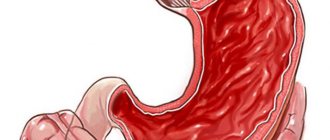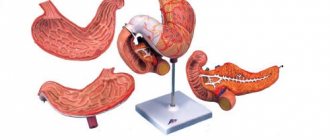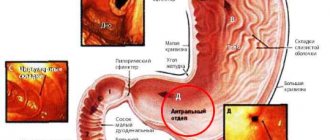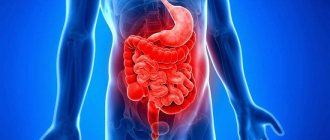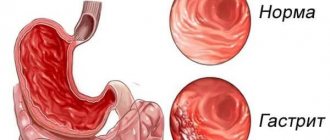Antral gastritis is a disease caused by inflammation of the gastric mucosa. In 95% of cases, the causative agent of the disease is the bacterium Helicobacter pylori, which has entered the antrum (lower section) of the stomach. Helicobacter pylori infection causes irritation of mucous tissues and disruption of the production of bicarbonates, which regulate the acidity of gastric juice. What is antral gastritis, what are the reasons for its development, symptoms and principles of treatment will be discussed in detail in this article.
Description
Antral gastritis (antrum gastritis) is a chronic inflammatory disease of the mucous tissues of the stomach, which is localized in the antrum, the lowest part of the stomach, where the transition to the duodenum is located. The mucous membrane of this part of the stomach produces the hormone gastrin, which stimulates acid production. The epithelial layer of the antrum of the stomach is covered by glandular cells that produce mucus, which serves as a protective layer for the mucous membrane.
In the antrum of the stomach, alkalization of the food bolus (chyme) occurs, that is, a decrease in the acidity of digested food before entering the intestine. The inflammatory process in the antrum blocks the production of bicarbonates (alkalinizing environment), which normalize acidity. The concentration of acid in the gastric juice increases and acidic contents pass into the intestines, causing irritation and inflammation.
The muscles of the antrum of the stomach push chyme into the duodenum and then into the small intestine. The inflammatory process disrupts the digestive functions of the stomach, impairs the digestion and movement of food, and leads to atrophy of areas of the gastric mucosa.
Antral gastritis is an early stage of chronic gastritis; as it progresses, it turns into a focal atrophic form of gastritis.
Metastases in stomach cancer
As the neoplasm grows, it grows through the wall of the stomach and penetrates into the surrounding tissues. Such metastases are called implantation. Depending on the location of the tumor, it may invade the site or other neighboring organs. In the case of the antrum, the duodenum is more susceptible to metastases than others.
When cancer cells enter the lymphatic or blood vessels, lymphogenous and hematogenous metastasis is observed. Since the stomach has an extensive lymphatic network, spread by the lymphatic route occurs very quickly. This can happen already at the first stage.
First, the lymph nodes located in the ligamentous apparatus of the stomach are affected. Next, the process migrates to the lymph nodes located along the arterial trunks. Finally, metastases penetrate to distant lymph nodes and organs. Most often the liver, spleen, intestines, lungs, and pancreas are affected. Hematogenous metastases in gastric cancer are usually found in the lungs, kidneys, and brain. bones.
Secondary tumors are treated surgically. In infiltrative forms, preference is given to removing all lymph nodes susceptible to the appearance of metastases in them. The result is secured with chemotherapy, which helps destroy micrometastases - cancer cells located in the body.
Causes
The development of antral gastritis can be caused by the following factors:
- Helicobacter pylori infection in the stomach;
- weak pylorus (pylorus), which causes the release of intestinal contents into the stomach;
- poor diet, excess salt intake;
- predisposition to allergies;
- long-term use of certain medications;
- stress and nervous shock;
- smoking and alcohol abuse;
- infectious diseases (for example, candidiasis, HIV);
- extensive burns of the body affecting the stomach;
- harmful production conditions (contact with lead, coal, etc.)
- diseases of the endocrine and cardiovascular systems, respiratory and gastrointestinal tract, kidneys;
- helminthic infestation.
Varieties
Antral gastritis according to the clinical picture is divided into two forms:
- acute, arising from exposure to bacterial, food or chemical irritants;
- chronic, appearing as a complication of acute gastritis, and having stages of relapse (exacerbation) and remission.
According to the nature and degree of manifestations, antral gastritis is classified into several types:
- superficial _ This is an erythematous exudative form of gastritis with damage to the antrum. It is characterized by inflammation of the uppermost mucous layer of the stomach walls. The simplest form of gastritis, without atrophy of the mucous tissues, when there are no scars and the glands are not affected. In some cases, it may occur in certain areas of the gastric mucosa;
- catarrhal _ The symptoms are similar to superficial. It is considered the initial form of the disease. The non-atrophic process involves the most superficial layer of the stomach walls without spreading deeper, with a moderate degree of gland activity. With diffuse catarrhal gastritis, inflammation spreads to the entire surface of the stomach;
- erythematous . Bright pink oval rashes are observed on the gastric mucosa, prone to the development of erosions. Inflammations can be focal, in individual areas of the mucosa, or diffuse, localized over most of the stomach. Exudative erythematous gastritis causes serious damage to the mucous tissues of the stomach of a general nature;
- erosive . Damage to the gastric mucosa is much more significant. Inflammation causes the formation of acute erosions of the antrum and aphthous papules. Aphthous papules can be single or multiple. The glands of the organ are affected, scars and foci of hyperemia in the stomach are formed, the mucous membrane swells, and bleeding is observed;
- hyperplastic (nodular) . The mucous tissue of the stomach thickens, and many small cysts and polyps form. It can be diffuse and focal;
- grainy _ With this form of the disease, multiple cysts up to 2 cm in size form on the walls of the stomach. Bleeding often occurs;
- focal . There is a hyperemic mucosa with multiple lesions of the stomach tissue and areas of atrophy. Focal gastritis can be fundic, pyloroantral, pyloroduodenal;
- follicular (lymphoid) . A rare type of gastritis that develops from disorders in the immune system. Many lymphocytes are formed that clog the bicarbonate-producing glands. Growths (follicles) form;
- atrophic . This form of the disease is characterized by the development of pronounced atrophic processes in the mucous membrane, disruption of the functions of the gastric glands and the secretion of gastric juice. Intestinal dysplasia and metaplasia develop. Atrophic antrum gastritis precedes the formation of cancerous tumors;
- rigid . Occurs when there is sclerosis of the gastric walls with inflammation and scar formation, causing the antrum to narrow;
- mixed . Several forms of gastritis develop simultaneously. In this case, one patient may experience the formation of catarrhal, erosive and hyperplastic gastritis.
Antral gastritis is often combined with bulbitis - inflammation of the duodenal bulb caused by excess acid.
According to the severity of the clinical picture, antral gastritis is systematized into three stages:
- I – symptoms are mild, changes in tissue cells are insignificant;
- II – symptoms are moderate, atrophy of mucous tissues and infiltration of glands are observed;
- III – symptoms are very pronounced. Characterized by significant cell atrophy and tissue infiltration.
Benign neoplasms of the antrum
Non-cancerous formations of the antrum include polyps and lymphofollicular hyperplasia. Polyps arise from the proliferation of glandular epithelial cells. The antrum accounts for 60% of all gastric polyps.
They are characterized by single growth or the formation of an entire colony. They differ in shape and size (up to 30 mm). Identified against the background of other stomach diseases. They pose a threat of cancerous degeneration. They practically do not give any symptoms. Pain is caused by eating disorders. They can become twisted or pinched, causing blood to appear in the stool.
Based on their origin, antral polyps are divided into three types:
- inflammatory - begin with lymphoid follicles (from 70 to 90%);
- adenomas - grow from the glandular epithelium;
- specific - neoplasms in Pattes-Jeghers-Touraine syndrome, which is a hereditary pathology including hyperpigmentation of the skin and polyposis of the intestines, stomach, differ in glandular structure, pigment content (melanin), and rarely - muscle fibers.
Pattes-Jeghers-Touraine syndrome is also characterized by the appearance of spots on the face (xanthomas), in which the melanin pigment is located at the level of the basal layer of the epidermis and in the mucous membrane. Pigmentation appears in childhood and may decrease or disappear with age.
Lymphofollicular hyperplasia is accompanied by the growth or formation of follicular tissue in the submucosal layer of the stomach. The disease has no age-related advantages. Among the reasons, in addition to those described above, a special place is given to:
- herpes infection;
- autoimmune diseases;
- endocrine disorders;
- contact with carcinogens.
It is important that, according to observations, this type of hyperplasia most often precedes the formation of polyps.
Symptoms
Antral gastritis can develop asymptomatically for a long time. As the disease progresses, characteristic symptoms appear:
- a feeling of discomfort and pain in the epigastric region (usually under the ribs on the left side);
- flatulence;
- periodic nausea with periodic vomiting, heartburn;
- unpleasant taste in the mouth;
- gray coating on dry tongue;
- feeling of fullness in the stomach;
- diarrhea or constipation;
- sharp stomach cramps and spasms;
- difficult movement of the food bolus through the antrum;
- rapid heartbeat;
- poor appetite;
- increased body temperature;
- cardialgia (pain in the heart area);
- hypotension (low blood pressure);
- irritability;
- weakness, dizziness, drowsiness;
- gastric bleeding (with acute erosive gastritis). Severe vomiting streaked with blood and dark stool are observed.
Symptoms of antrum gastritis are most pronounced during severe stress or alcohol abuse.
Cancer tumor
Cancer (cancer in Latin or abbreviated cr) of the antrum accounts for up to 70% of malignant tumors of the stomach. There are:
- adenocarcinoma - formed from glandular cells, the most common tumor (90%);
- solid cancer is a rare neoplasm, the structure is not related to glandular elements;
- scirrhus cancer is an even rarer form, formed from connective tissue.
Specifics of antral cancer localization:
- infiltrative growth without the formation of clear boundaries;
- aggressive course with rapid metastasis;
- frequent relapses after gastric resection.
The most common cause of cancer is chronic atrophic gastritis. It causes three types of morphological changes:
- glandular atrophy - disappearance of mucosal cells;
- dysplasia - the appearance in the stomach of epithelium characteristic of the intestine (intestinal metaplasia) with correspondingly impaired properties;
- neoplasia - transformation into malignant cells.
Symptoms of antrum cancer, compared to those described above, are different:
- constant feeling of fullness or distension in the stomach area;
- nausea and vomiting, which patients induce themselves to alleviate the condition;
- aversion to food;
- significant exhaustion;
- patient irritability;
- temperature rise.
Tumor infiltration of stomach tissue is accompanied by destruction of blood vessels. Therefore, one of the signs is gastric bleeding (vomiting blood, black loose stools).
Diagnostics
Diagnosis of antral gastritis consists of a comprehensive examination of the patient, including instrumental studies:
- gastrography with contrast agent. Thickened relief folds in the pyloric region and peristalsis disturbances are observed;
- FEGDS. Redness, hyperemia and swelling of the mucous tissues of the antrum, hemorrhage are noted, erosive and papular gastropathy is detected. During the procedure, a tissue sample is removed for biopsy. Histological examination determines the severity of inflammation in the paragastric cavity and the number of Helicobacter bacteria on the gastric epithelium;
- gastroscopy. A urease test is carried out for Helicobacter pylori infection, for which a biopsy of mucous tissue is placed in a special environment, which, in the presence of bacteria, changes color to crimson. If the color of the medium does not change during the day, there are no bacteria in the stomach;
- a breath test that detects Helicobacter;
- ELISA. Detects antibodies to Helicobacter pylori infection in gastric juice, blood and saliva;
- intragastric pH-metry. Determines the level of acid in gastric juice;
- digital tomography;
- Ultrasound.
Treatment
To treat antral gastritis, a set of medical measures is prescribed:
- therapeutic diet;
- drug therapy;
- physiotherapeutic treatment;
- phytotherapy;
- surgical intervention (in severe cases).
Diet
A diet for antral gastritis promotes rapid recovery and improvement of the condition. Coarse foods that stimulate the secretion of gastric juice are excluded from the diet. It is necessary to reduce the amount of carbohydrates and increase the protein content in food. You need to eat at least 5 times a day in small portions. Dishes must be liquid or pureed.
Foods that are allowed and prohibited for antral gastritis:
| Allowed | Prohibited |
| white bread crackers | smoked, fried, spicy foods, spices |
| lean boiled meat (beef, rabbit, chicken), sea fish | pickled and canned foods |
| vegetable soups and purees | carbonated and alcoholic drinks |
| pasta | chocolate, coffee |
| steam cutlets and meatballs | baked goods, confectionery |
| weak tea, compote, jelly | products that cause fermentation: black bread, milk, sour cream, grapes, dried fruits |
Sample menu for the day:
| Breakfast | oatmeal, jelly |
| Lunch | soft-boiled egg, soft cheese |
| Dinner | pasta soup with low-fat broth, steam cutlet, boiled carrots, compote |
| Afternoon snack | vegetable puree, rosehip tincture |
| Dinner | boiled fish with rice, fruit puree, weak tea |
| Before going to bed it is useful to drink a glass of kefir |
Drug therapy
How to treat antral gastritis with medications is determined by the doctor individually in each specific case. Alkalinization therapy is carried out.
Video on the topic:
The treatment regimen includes the following groups of drugs:
- antibiotics (in cases where the disease is caused by Helicobacter pylori infection). Several drugs are prescribed simultaneously (Ampicillin, Metronidazole, Clarithromycin, Tetracycline);
- proton pump inhibitors (Omeprazole, Gastrozol, Lanzoptol);
- enzyme preparations (Pancreatin, Mezim, Festal);
- antacids and coating agents (De-Nol, Almagel, Gastal, Maalox);
- antispasmodics (Drotaverine, Papaverine, No-shpa);
- prokinetics are prescribed when reflux is observed (Cerucal, Motilium);
- complex of vitamins.
Physiotherapy
Physiotherapeutic procedures for antral gastritis help to quickly stop the manifestations of the disease.
If necessary, the following are prescribed:
- ultrasound (for pain relief);
- galvanization with electrophoresis of drugs (for spasms);
- modulated current (to eliminate dyspepsia and pain);
- acupuncture;
- infrared laser therapy;
- UHF therapy;
- medicinal baths (with sage, mint, pine needles).
After stopping the exacerbation of the disease, the following is prescribed:
- mud therapy;
- paraffin therapy;
- treatment with mineral water.
Phytotherapy
For antral gastritis, folk remedies are often used as an addition to the main treatment. Some simple and effective recipes:
- cabbage juice Drink ½ glass of freshly squeezed juice each time before meals;
- potato juice . Drink ½ glass of fresh juice in the morning on an empty stomach before meals;
- aloe juice Squeeze the juice from aloe leaves and consume 10 ml. half an hour before meals. Duration of treatment is 30 days;
- propolis tincture (can be bought at a pharmacy) . Take 20-30 drops before bedtime;
- burdock root . Pour 10 grams of root with a glass of boiling water, cool and take ½ glass 4 times a day;
- mix chamomile, linden, mint and flax seed . Brew like tea and drink 250 ml. 3-4 times a day;
- calamus root . 250 ml is poured. boiling water 1 teaspoon of root, infuse for half an hour, strain and take ½ cup before meals.
Surgical intervention
Surgery is resorted to when absolutely necessary, when conservative therapy has not brought results.
Surgical intervention is performed in the following cases:
- stomach bleeding;
- gatekeeper weaknesses;
- tumor formation;
- scarring of the stomach walls.
Using electrocoagulation, hemostasis is performed or clips are applied to damaged vessels. According to indications, in severe cases, resection of the affected area of the stomach is performed.
Observation after surgery and relapses
After treatment, patients should be monitored by a local oncologist. In the first year, a person needs to be examined once every 3 months, then once every 6 months.
Scope of observation:
- general blood analysis;
- Ultrasound of the abdominal organs;
- X-rays of light;
- fibrogastroscopy;
- inspection and palpation.
Such measures are necessary to prevent relapses, which occur frequently, especially after non-radical operations. The patient may experience a second tumor next to the previously removed one, or metastases in other organs. In such cases, a new operation and/or chemo-radiation therapy is performed. With each new relapse, survival prognosis worsens and, ultimately, disease progression leads to death.
Complications
With antral gastritis, in case of untimely or incorrect treatment, severe complications arise, such as:
- stenosis of the gastric walls;
- scars on the walls of the stomach;
- dysbacteriosis;
- dizziness and insomnia;
- anemia;
- formation of ulcers;
- pancreatitis;
- stomach bleeding;
- polyps on the walls of the stomach;
- acute pangastritis.
The most dangerous consequence of antral gastritis is the occurrence of an oncological process (cancer). If any disturbances in the functioning of the gastrointestinal tract occur, it is necessary to promptly contact a medical institution for examination.
List of references: https://atvmedia.ru/materials/gastrit-antralnogo-otdela-zheludka https://www.passion.ru/health/zhkt/antralnyy-gastrit-simptomy-i-lechenie-85966.htm https:/ /www.obozrevatel.com/health/bolezni/antralnyij-gastrit.htm https://www.smclinic-spb.ru/doctor/gastroenterolog/zabolevania/990-gastrit-simptomy-i-lechenie https://profi.ru /content/doctor_info/antralnyj-gastrit-ego-simptomy-i-lechenie/ https://ru.wikipedia.org/wiki/Gastritis https://www.gastroscan.ru/patient/disease/01/07/ Osipov Yu S.S., Zhigunova T.P., Ebzeev A.Kh., Pak A.G. Helicobacter antral gastritis at the stage of resort treatment // Medical Bulletin of the South of Russia. 2012. No. 3 premium-clinic.ru/simptomy-i-zabolevaniya/antralnyy-gastrit/ Notes from the author of the article, based on personal experience. This material is purely subjective and is not a guide to action. Only a qualified specialist can determine an accurate diagnosis and prescribe treatment.
Article last modified: 03/18/2020
Раскованные кисы с redbora.ru встречаются только с адекватными, порядочными, чистоплотными мужчинами, реальные шлюхи Бор, если хочешь всё самое-самое. Милые реальные шлюхи Бор, горячие и прелестные, они такие модельные и молоденькие, что у тебя будет сегодня классный секс. Прелестницы ждут тебя.
